How to Use Meeting Feedback to Improve Your Skills

Introduction

Introducing the Topic of Meeting Feedback and Its Importance
Meeting feedback is an invaluable tool for personal and professional development, enabling business and team leaders to identify areas for improvement and enhance their skills. By gathering and effectively utilizing feedback, leaders can create more productive meetings, foster collaboration, and drive better results for their teams and organizations.
Preview of Key Strategies and Best Practices
In this article, I will explore the following strategies and best practices for using meeting feedback to improve your skills:
- Understanding the types of meeting feedback
- Asking for feedback
- Analyzing feedback
- Implementing feedback
- Evaluating feedback
By adopting these strategies, you will be better equipped to capitalize on the insights provided by feedback, ultimately leading to improved meeting outcomes and professional growth.
Understand the Types of Meeting Feedback
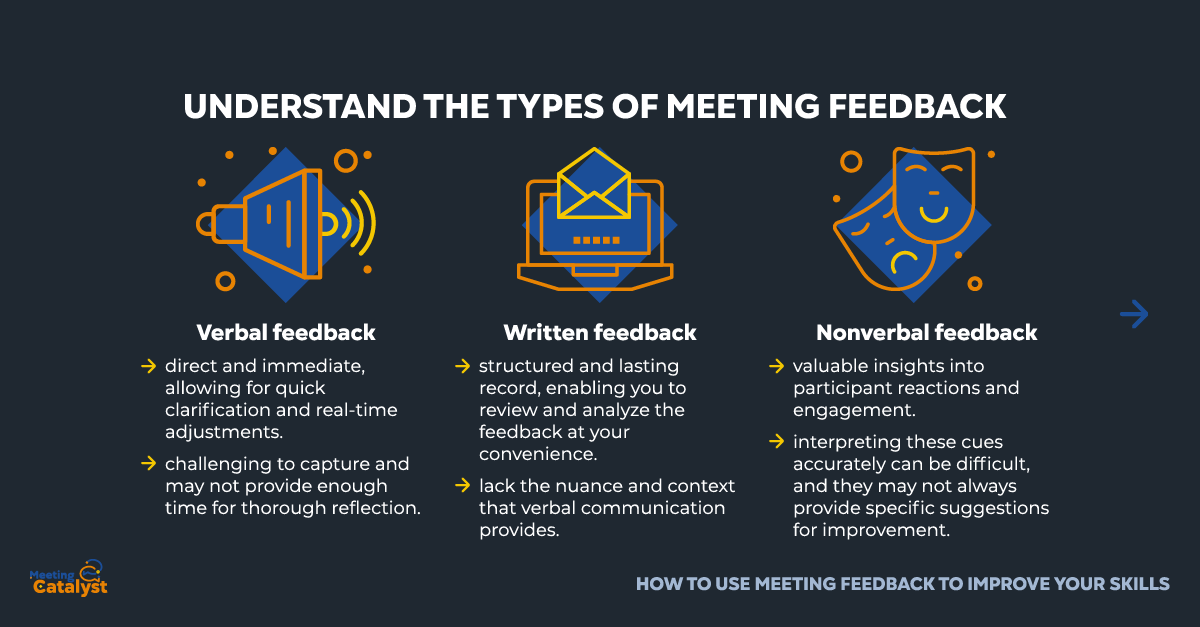
Exploring the Different Types of Meeting Feedback
To effectively use feedback for personal and professional growth, it's essential to understand the various types of meeting feedback. Each type has its advantages and disadvantages, and knowing when to use them can help you gather more insightful and actionable feedback. The three primary types of meeting feedback are:
- Verbal feedback: Spoken comments or suggestions provided during or after a meeting.
- Written feedback: Written remarks or evaluations shared via email, surveys, or other written formats.
- Nonverbal feedback: Unspoken cues, such as body language or facial expressions, that can indicate participants' reactions or engagement levels.
Advantages and Disadvantages of Each Type
- Verbal feedback is direct and immediate, allowing for quick clarification and real-time adjustments. However, it can be challenging to capture and may not provide enough time for thorough reflection.
- Written feedback offers a more structured and lasting record, enabling you to review and analyze the feedback at your convenience. However, it may lack the nuance and context that verbal communication provides.
- Nonverbal feedback can offer valuable insights into participant reactions and engagement, but interpreting these cues accurately can be difficult, and they may not always provide specific suggestions for improvement.
Examples of Successful Meeting Feedback Strategies
By combining these different types of feedback, you can gather a more comprehensive understanding of your meeting performance and areas for improvement. For example, as a team leader you might use a post-meeting survey to collect written feedback, schedule one-on-one follow-up discussions for verbal feedback, and pay close attention to participants' body language and facial expressions during meetings to identify any potential issues or concerns.
Ask for Feedback
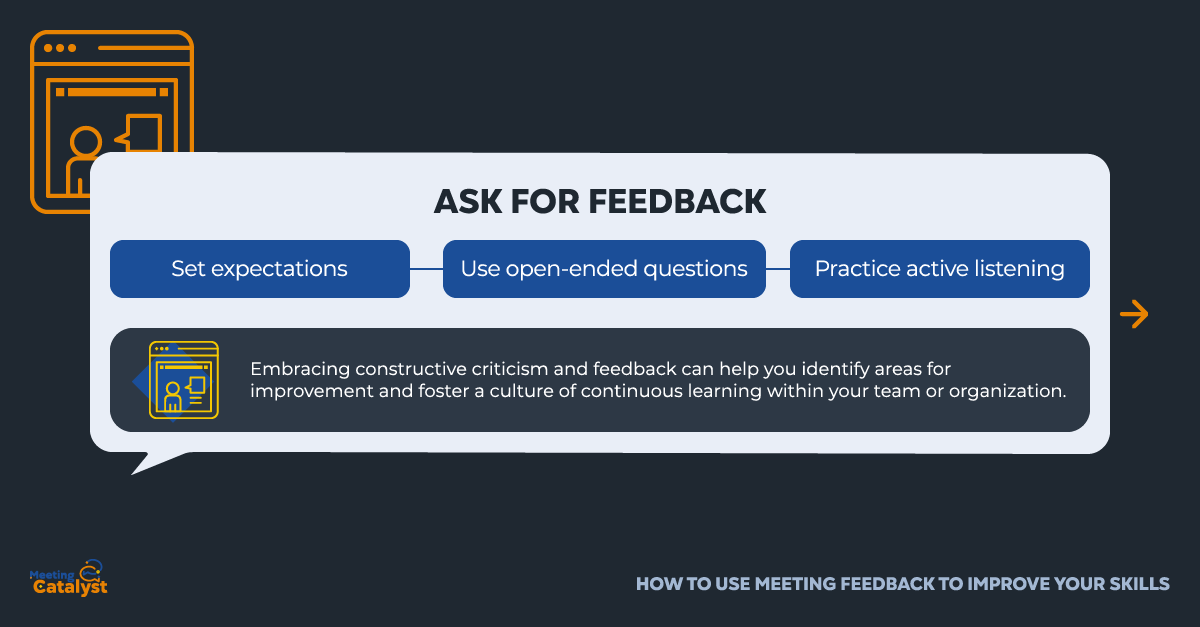
The Importance of Asking for Feedback and Being Open to Constructive Criticism
Asking for feedback is a crucial step in leveraging it for personal and professional development. By actively soliciting input from meeting participants, you demonstrate a willingness to learn, grow, and enhance your leadership skills. Embracing constructive criticism and feedback can help you identify areas for improvement and foster a culture of continuous learning within your team or organization.
Tips for Soliciting Feedback Effectively
To gather meaningful and actionable feedback, consider adopting the following strategies:
- Set expectations: Clearly communicate to participants that you value their feedback and are eager to learn from their insights. Encourage honesty and constructive criticism.
- Use open-ended questions: Asking open-ended questions, such as "What can I improve on?" or "How can we make our meetings more effective?", invites more detailed responses and fosters thoughtful discussion.
- Practice active listening: When receiving feedback, listen attentively, avoid interrupting, and ask follow-up questions to ensure you fully understand the feedback provided.
Examples of Successful Feedback Solicitation Strategies
One effective feedback solicitation strategy is implementing regular feedback sessions, either during or after meetings. This could involve dedicating the last few minutes of a meeting to discuss any suggestions or concerns, or scheduling a separate debriefing session to review the meeting and gather feedback. Another approach is using anonymous feedback tools, such as online surveys or suggestion boxes, to encourage candid responses and ensure all participants feel comfortable sharing their thoughts.
Analyze Feedback
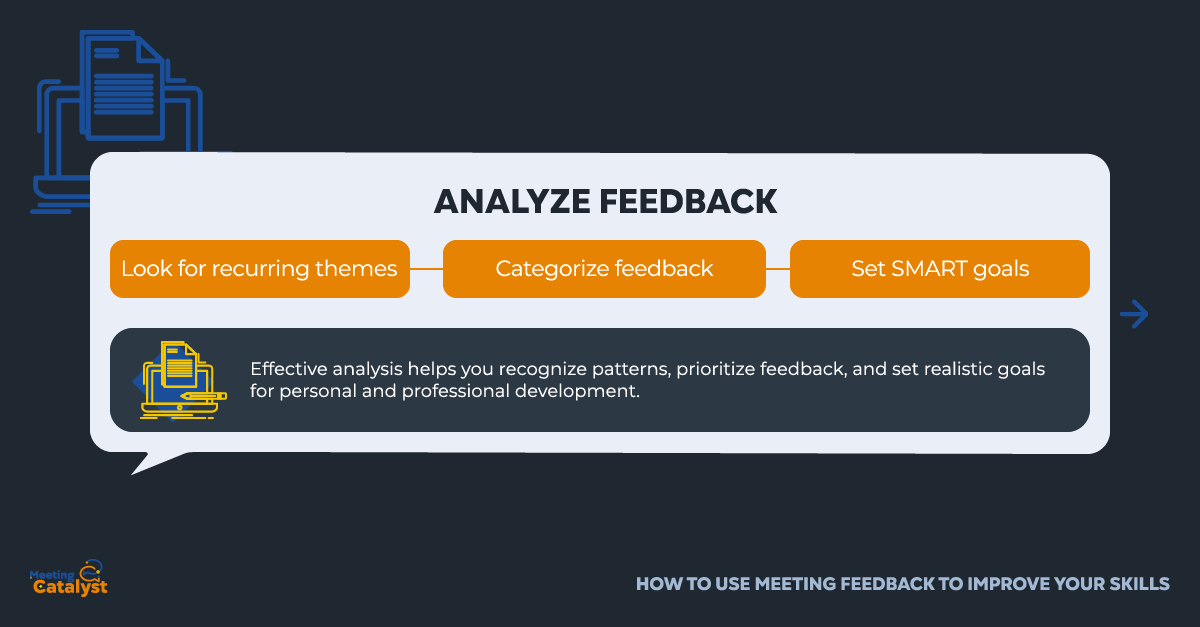
How to Analyze Meeting Feedback for Improvement
Once you've gathered feedback from various sources, it's time to analyze the information and identify areas for improvement. Effective analysis helps you recognize patterns, prioritize feedback, and set realistic goals for personal and professional development.
Tips for Identifying Patterns, Prioritizing Feedback, and Setting SMART Goals
- Look for recurring themes: Review the feedback and take note of any recurring issues, suggestions, or concerns. These patterns can help you pinpoint areas that require attention.
- Categorize feedback: Organize the feedback into categories, such as communication, time management, or meeting structure. This can help you identify specific areas for improvement and prioritize your efforts.
- Set SMART goals: Based on your analysis, establish SMART (Specific, Measurable, Achievable, Relevant, and Time-bound) goals for your development. For example, if you've identified that your meetings tend to run over time, you might set a goal to reduce meeting duration by 15% within the next three months.
Examples of Successful Feedback Analysis Strategies
A successful feedback analysis strategy might involve using a feedback tracking tool, such as a spreadsheet or project management software, to compile and categorize feedback for easy analysis. You can also hold regular feedback review sessions with your team or a mentor to discuss recurring themes and brainstorm solutions together. Additionally, you could utilize a performance improvement plan to outline your SMART goals, document your progress, and track your achievements over time.
Implement Feedback
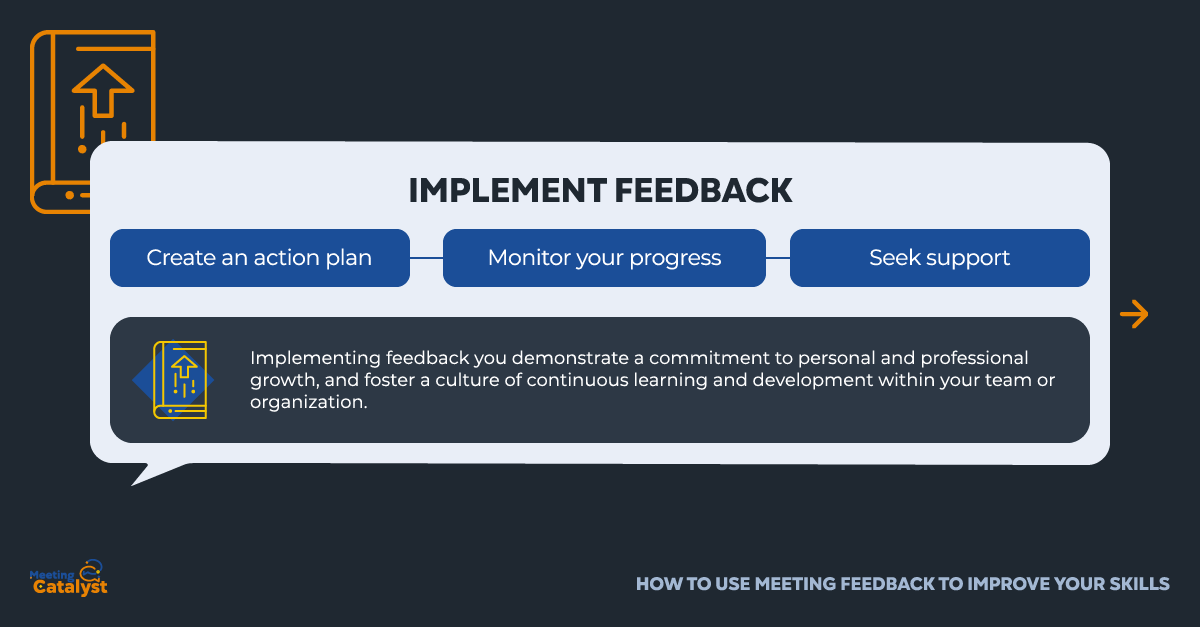
The Importance of Implementing Feedback for Personal and Professional Development
Implementing feedback is a critical step in translating insights into tangible improvements. By putting the feedback into action, you demonstrate a commitment to personal and professional growth, and foster a culture of continuous learning and development within your team or organization.
Tips for Developing an Action Plan, Tracking Progress, and Seeking Additional Support
- Create an action plan: Based on your feedback analysis and SMART goals, develop a clear action plan outlining the steps you'll take to improve your skills or meeting effectiveness. Break down your goals into manageable tasks and assign deadlines to maintain momentum.
- Monitor your progress: Regularly review your action plan and track your progress towards achieving your goals. This can help you stay accountable, identify any obstacles, and make adjustments as needed.
- Seek support: Reach out to colleagues, mentors, or coaches for guidance, advice, or encouragement as you work towards your goals. Sharing your progress and learning from others' experiences can help you stay motivated and gain valuable insights.
Examples of Successful Feedback Implementation Strategies
One example of a successful feedback implementation strategy is adopting a continuous improvement mindset and revisiting your action plan after each meeting. This can involve making adjustments to meeting agendas, incorporating new communication techniques, or implementing time management strategies based on the feedback received.
Another approach is to create a feedback loop with your team, where you share updates on your progress and solicit ongoing feedback on your improvements. This can help you fine-tune your strategies and ensure that you're making progress towards your goals.
Lastly, consider participating in relevant workshops, seminars, or training programs to further develop your skills and learn from industry experts. This can provide you with new ideas and approaches to enhance your meeting management and leadership abilities.
Evaluate Feedback
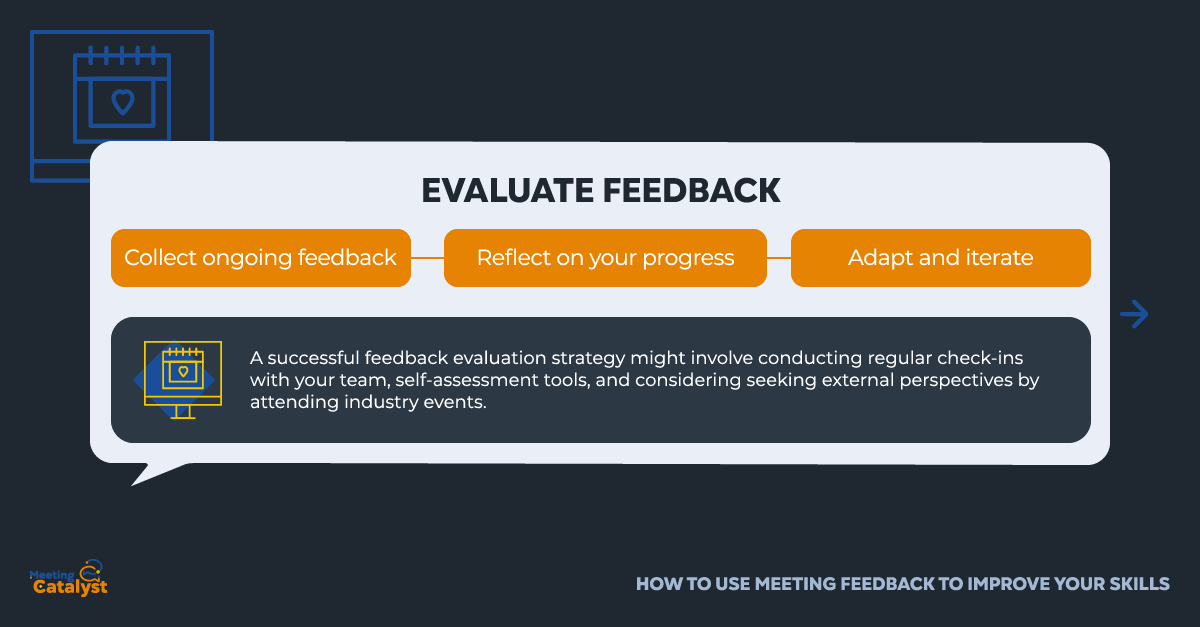
Evaluating the Effectiveness of Feedback and Its Impact on Your Skills and Performance
To maximize the benefits of meeting feedback, it's crucial to evaluate its effectiveness and assess the impact on your skills and performance. This involves gathering additional feedback, reflecting on your progress, and making adjustments as needed to ensure continuous improvement.
Tips for Gathering Additional Feedback, Reflecting on Progress, and Making Adjustments
- Collect ongoing feedback: Continue to solicit feedback from meeting participants as you implement changes. This can help you gauge the effectiveness of your improvements and identify any areas that may require further adjustment.
- Reflect on your progress: Take the time to review your action plan, track your achievements, and consider the lessons you've learned. Reflecting on your progress can help you recognize your growth and stay motivated to continue improving.
- Adapt and iterate: Be prepared to make adjustments to your strategies and goals based on the feedback received and your own self-assessment. This flexibility allows you to refine your approach and stay on track towards achieving your objectives.
Examples of Successful Feedback Evaluation Strategies
A successful feedback evaluation strategy might involve conducting regular check-ins with your team to discuss the impact of the changes you've implemented. This can provide valuable insights into the effectiveness of your strategies and help you identify areas for further improvement.
Another approach is to use self-assessment tools, such as journaling or self-evaluation forms, to document your progress and reflect on your growth. This can help you gain a better understanding of your strengths and areas for development.
Lastly, consider seeking external perspectives by attending industry events, networking with peers, or participating in professional development programs. This can expose you to new ideas and best practices, and help you assess your own performance in the context of broader industry standards.
Conclusion
Summarizing Key Strategies and Best Practices for Using Meeting Feedback to Improve Your Skills
Effectively utilizing meeting feedback is essential for personal and professional development. By understanding the types of feedback, actively soliciting it, analyzing the insights, implementing changes, and evaluating the impact on your skills and performance, you can continuously refine your abilities and excel in your role.
Reiterating the Importance of Feedback for Personal and Professional Development
Feedback is a powerful tool for growth, and incorporating it into your development journey can help you become a more skilled and effective leader. Embracing a culture of continuous learning and improvement can lead to better meetings, stronger team dynamics, and increased overall success for your organization.
A Call-to-Action for Readers
Now is the perfect time to start implementing these strategies in your own feedback and development journey. Take the first step by soliciting feedback from your next meeting, and use the insights to create a tailored action plan for improvement. By embracing the power of feedback, you can unlock your full potential and foster a culture of excellence in your organization.